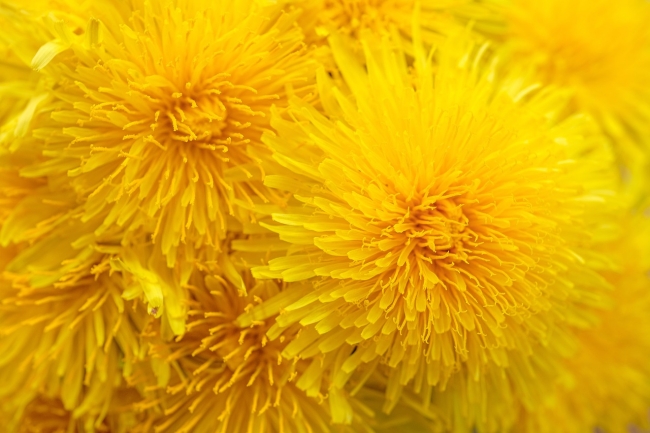How many of us when we were children, and, for some of us even as adults (ahem), have done this:

We often overlook this widespread flower powerhouse. But the dandelion is an impressive and beneficial plant with quite an interesting history. Join Appalachia Bare as we unearth the dandelion – “The Little Plant That Roars.”1)Zak, Victoria. 1999. 20,000 Secrets of Tea: The Most Effective Ways to Benefit from Nature’s Healing Herbs. New York: Dell Publishing.
The Basics
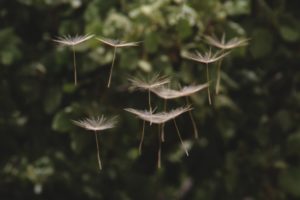
The dandelion (Taraxacum officinale) is the most recognized and most prolific flower in the world, found in the cold arctic region, the world’s hot zones, and in mountainous areas.2)Creasey, Bill and Bob Staggenborg. 2017. “Dandelions.” Nature Guys. Podcast Pro, Genesis Framework, May 2. Other names for this perennial are: blowball, peasant’s clock, shepherd’s clock, cankerroot, down-head, yellow gowan, witches’ gowan, milk-witch, cankerwort, lion’s tooth, priest’s crown, puffball, swine snout, white endive, and wild endive.
The name “dandelion” originated from a 15th century French surgeon who saw the likeness of a lion’s teeth in the leaves, so he named the flower “dens lion, or dande lion.”3) Zak, Victoria. 1999. 20,000 Secrets of Tea: The Most Effective Ways to Benefit from Nature’s Healing Herbs. New York: Dell Publishing. p. 111 In Cherokee, the dandelion is hu tsi la ha.4)Garrett, J. T. 2003. The Cherokee Herbal. Rochester: Bear & Company.
The plant has a long blooming season – from late winter to late fall. The naked eye sees the dandelion as a single yellow flower. In reality, it’s structured in a cluster of multiple flowers – a “composit of many tiny florets.”5)Creasey, Bill and Bob Staggenborg. 2017. “Dandelions.” Nature Guys. Podcast Pro, Genesis Framework, May 2. The puffy top, or, “seed head,” has anywhere between 50 to 175 seeds and about 50 percent of those seeds will germinate.6)Creasey, Bill and Bob Staggenborg. 2017. “Dandelions.” Nature Guys. Podcast Pro, Genesis Framework, May 2. As we all know, they aren’t terribly picky about soil. They’ll even grow in concrete cracks. They love the sun and are quite adaptive to drought. The taproots can grow as much as 15 feet below the soil.7)Creasey, Bill and Bob Staggenborg. 2017. “Dandelions.” Nature Guys. Podcast Pro, Genesis Framework, May 2.
The Origins
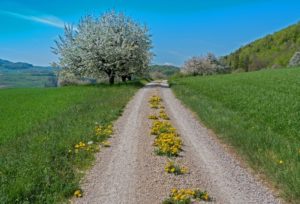
The flower was established in Eurasia. Settlers “purposely brought this plant” to America for its medicinal and culinary value, its material-dying purposes, and as a remnant from their homeland. Surprisingly, people once cleared areas to plant dandelions. Gardeners would “actually weed around” them.8)Creasey, Bill and Bob Staggenborg. 2017. “Dandelions.” Nature Guys. Podcast Pro, Genesis Framework, May 2. As mentioned, this plant loves the sun. So, how did these flowers spread out West, where tall grasses block the bright star? The clever plant grew in wagon ruts along trails, and, as dandelions dotted the way, the trail became known as “the golden pass.”9)Creasey, Bill and Bob Staggenborg. 2017. “Dandelions.” Nature Guys. Podcast Pro, Genesis Framework, May 2. The plant’s value decreased in the 20th century when the aesthetics of a perfect lawn became the “in” thing.
Caution: Please consult your doctor or a professional before ingesting.
Medicinal
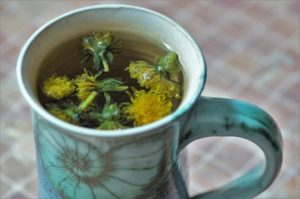
The dandelion’s medicinal properties are astounding. The entire plant is packed with iron, potassium, and vitamins A, B C, D, and K.10)Wigginton, Eliot, ed. 1973. Foxfire 2. Garden City: Anchor Press. P. 8911)Zak, Victoria. 1999. 20,000 Secrets of Tea: The Most Effective Ways to Benefit from Nature’s Healing Herbs. New York: Dell Publishing. p. 11112)Creasey, Bill and Bob Staggenborg. 2017. “Dandelions.” Nature Guys. Podcast Pro, Genesis Framework, May 2. It contains “more vitamin A than spinach”13)Spinach has about 366% vitamin A per cup and “more vitamin C than tomatoes.”14)1 medium tomato has 26% vitamin C15)Creasey, Bill and Bob Staggenborg. 2017. “Dandelions.” Nature Guys. Podcast Pro, Genesis Framework, May 2. When used as a tonic, the plant reportedly strengthens a woman after childbirth and can also treat heart trouble.16)Garrett, J. T. 2003. The Cherokee Herbal. Rochester: Bear & Company. It “very effectually opens obstructions of the liver and gall. It wonderfully opens the passages of the urine both in old and young,” and it effectively cleans abscesses and ulcers.17)Doane, Nancy Lock. n.d. Indian Doctor Book. Charlotte: Nancy Locke Doane, publisher. It helps lower blood pressure. The settlers found it cured a variety of ailments: “baldness, toothache, rotting gums, dandruff, sores, fevers, weakness, lethargy, and depression.”18)Creasey, Bill and Bob Staggenborg. 2017. “Dandelions.” Nature Guys. Podcast Pro, Genesis Framework, May 2. Interestingly, most of these ailments were due to vitamin deficiencies, so, given the dandelion’s plentiful vitamins and nutrients, it’s no wonder they found this a “cure all.” According to John Lust’s The Herb Book (1974), the plant is used for two things: to increase bile and to “remove excess water” in the body that might cause liver problems. (p. 171)
The Root of It All
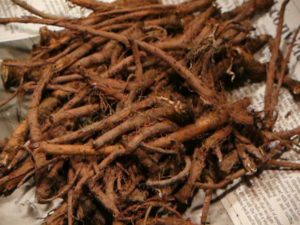
The root can eliminate toxins such as pesticides and pollutants from the body.19) Lust, John. 1974. The Herb Book. New York: Bantam Books. P. 171 The plant “contains twenty-eight parts sodium” and these “salts purify the blood and help to neutralize the acids in the blood.”20)Kloss, Jethro. 1995. Back to Eden. Loma Linda: Back to Eden Publishing.P. 123 Excess salts are removed through urine. As a tonic, the roots help cool and clean the liver. “It has a long history of use in China and India for all liver complaints, including hepatitis, jaundice, boils, and abscesses.”21)Zak, Victoria. 1999. 20,000 Secrets of Tea: The Most Effective Ways to Benefit from Nature’s Healing Herbs. New York: Dell Publishing. p. 112 People in the United States separate the leaves and roots and use them according to the type of tea or other purpose. In China, the whole plant is used.22)Zak, Victoria. 1999. 20,000 Secrets of Tea: The Most Effective Ways to Benefit from Nature’s Healing Herbs. New York: Dell Publishing. p. 111 The Chinese also insist it helps with mood swings, since Chinese medicine links mood swings with “too much liver heat.”
Toothy Leaves
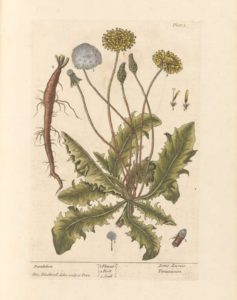
Dandelion leaves are “dentate basal”23)Wigginton, Eliot, ed. 1973. Foxfire 2. Garden City: Anchor Press. and release a milky material as they mature. They grow close to the ground. Dandelion tea made from leaves helps treat anemia since the leaves are packed with iron.24)Zak, Victoria. 1999. 20,000 Secrets of Tea: The Most Effective Ways to Benefit from Nature’s Healing Herbs. New York: Dell Publishing. p. 111 Further, the tea acts as a “mild laxative” and can assist with constipation, bloating and weight loss. The tea aids in digestion since it “stimulate[s] the flow of natural digestive juices.”25)Zak, Victoria. 1999. 20,000 Secrets of Tea: The Most Effective Ways to Benefit from Nature’s Healing Herbs. New York: Dell Publishing. p. 111 Since the leaves have a high potassium content, a cool or hot tea made from them makes an excellent diuretic. Diuretics typically deplete potassium, “but dandelion leaves restore it.”26)Zak, Victoria. 1999. 20,000 Secrets of Tea: The Most Effective Ways to Benefit from Nature’s Healing Herbs. New York: Dell Publishing. p. 111 With its diuretic and antibacterial qualities, the tea also helps cleanse the prostate.27)Zak, Victoria. 1999. 20,000 Secrets of Tea: The Most Effective Ways to Benefit from Nature’s Healing Herbs. New York: Dell Publishing. pgs. 112-113 It may also help dissolve kidney and bladder stones.28)Zak, Victoria. 1999. 20,000 Secrets of Tea: The Most Effective Ways to Benefit from Nature’s Healing Herbs. New York: Dell Publishing. p. 111 Some say the leaves can cure warts over time.
Culinary
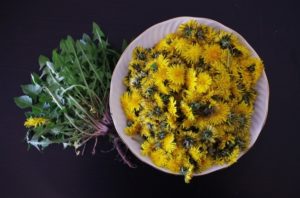
Dandelion leaves can be eaten as greens, though one must gather a very large amount to make a serving because they “cook down.”29)Wigginton, Eliot, ed. 1973. Foxfire 2. Garden City: Anchor Press. P. 89 To make greens or salad, it’s best to gather the leaves when they’re young because the milky substance in mature leaves make the greens bitter. An important thing to consider: be careful not to pick anything where chemicals such as weed killer have been sprayed.
Dandelion leaves can be used in quiches, quesadillas, jellies, syrup, etc. The flowers can be “breaded and fried”30)Creasey, Bill and Bob Staggenborg. 2017. “Dandelions.” Nature Guys. Podcast Pro, Genesis Framework, May 2. or used to make dandelion wine. The roots can be dried, ground, and roasted to make a coffee substitute. The root can also be cooked as a vegetable and is said to have a carrot-like flavor.31)Creasey, Bill and Bob Staggenborg. 2017. “Dandelions.” Nature Guys. Podcast Pro, Genesis Framework, May 2.
A Nuisance

Dandelions are not technically invasive. They don’t damage or deaden other native plants. The hosts on the podcast Nature Guys, a truly excellent podcast about all things nature with a cadre of experts, give a series of stark statistics about pesticides and insecticides. Forty billion dollars is spent every year in the United States to make our lawns look great. Thirty percent of our water is used to water lawns. The lawn acreage in this country is around 30 million acres, and we’re putting 80 million pounds of pesticides on them every year – all for aesthetics, not to mention the cost.32)The 80 million statistic only accounts for lawns – not agriculture The dangers are quite serious. Some homes have signs warning people and pet owners not to walk on the lawns because they’ve recently been treated with chemicals. An estimated seven million birds are killed every year from insecticides. And what happens when rain comes? Those chemicals wash away, potentially poisoning our water system. Read the following from the United States Environmental Protection Agency:
The health effects of pesticides depend on the type of pesticide. Some, such as the organophosphates and carbamates, affect the nervous system. Others may irritate the skin or eyes. Some pesticides may be carcinogens. Others may affect the hormone or endocrine system in the body.
A person can get rid of dandelions through natural ways. The Nature Guys also offer a few options here. One way is to just let grass grow about three to four inches. The grass will shade the dandelions, blocking the plant’s much-needed sun, and they’ll die off. Another way takes a little longer but works in the end and that’s using a vinegar spray. Vinegar, however, will also kill every other plant and grass so one must be careful when applying.
Lore and Magick
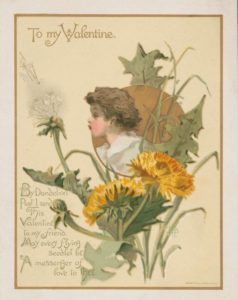
Quite a few interesting pieces of folklore and magickal properties exist about the dandelion. Here are some:
- Blow all the seeds away and a wish will come true.33)Dandelion Delight. n.d. “Dandelion Folklore.” Dandelion Delight. Accessed Aug 2021.
- Blow the dandelion seeds to the wind and carry messages to a loved one.34)Dandelion Delight. n.d. “Dandelion Folklore.” Dandelion Delight. Accessed Aug 2021.
- The flower represents “three celestial bodies”
- The yellow flower represents the sun
- The puffy seed head represents the moon
- The individual seeds represent the stars35)Creasey, Bill and Bob Staggenborg. 2017. “Dandelions.” Nature Guys. Podcast Pro, Genesis Framework, May 2.
- The tallest dandelion stalk a child finds in early spring indicates how many inches that child will grow by year’s end.36)Dandelion Delight. n.d. “Dandelion Folklore.” Dandelion Delight. Accessed Aug 2021.
- Associated with goddesses Aphrodite and Hecate37)Wigington, Patti. Updated 2019. “Dandelion Magic and Folklore.” Learn Religions. March 11.
- Dandelion flowers “always open” around five o’clock in the morning, and shut at sundown. Consequently, it has been called the “shepherd’s clock,” or “peasant’s clock.”38)Dandelion Delight. n.d. “Dandelion Folklore.” Dandelion Delight. Accessed Aug 2021.
- Put a dandelion in a bride’s bouquet and the couple will have good luck.39)Dandelion Delight. n.d. “Dandelion Folklore.” Dandelion Delight. Accessed Aug 2021.
- Called “Pee-beds” in certain countries. Children were told if they picked a dandelion, they’d pee in the bed.40)Plant-Lore: Collecting the folklore and uses of plants. n.d. “Dandelion.” Plant-Lore: Collecting the folklore and uses of plants. Aug. Accessed 2021.
**Featured Image by Bruno-Germany on Pixabay
References
| ↑1 | Zak, Victoria. 1999. 20,000 Secrets of Tea: The Most Effective Ways to Benefit from Nature’s Healing Herbs. New York: Dell Publishing. |
|---|---|
| ↑2, ↑5 | Creasey, Bill and Bob Staggenborg. 2017. “Dandelions.” Nature Guys. Podcast Pro, Genesis Framework, May 2. |
| ↑3 | Zak, Victoria. 1999. 20,000 Secrets of Tea: The Most Effective Ways to Benefit from Nature’s Healing Herbs. New York: Dell Publishing. p. 111 |
| ↑4 | Garrett, J. T. 2003. The Cherokee Herbal. Rochester: Bear & Company. |
| ↑6, ↑7, ↑8, ↑9, ↑12, ↑15, ↑18, ↑30, ↑31, ↑35 | Creasey, Bill and Bob Staggenborg. 2017. “Dandelions.” Nature Guys. Podcast Pro, Genesis Framework, May 2. |
| ↑10 | Wigginton, Eliot, ed. 1973. Foxfire 2. Garden City: Anchor Press. P. 89 |
| ↑11, ↑25, ↑28 | Zak, Victoria. 1999. 20,000 Secrets of Tea: The Most Effective Ways to Benefit from Nature’s Healing Herbs. New York: Dell Publishing. p. 111 |
| ↑13 | Spinach has about 366% vitamin A per cup |
| ↑14 | 1 medium tomato has 26% vitamin C |
| ↑16 | Garrett, J. T. 2003. The Cherokee Herbal. Rochester: Bear & Company. |
| ↑17 | Doane, Nancy Lock. n.d. Indian Doctor Book. Charlotte: Nancy Locke Doane, publisher. |
| ↑19 | Lust, John. 1974. The Herb Book. New York: Bantam Books. P. 171 |
| ↑20 | Kloss, Jethro. 1995. Back to Eden. Loma Linda: Back to Eden Publishing.P. 123 |
| ↑21 | Zak, Victoria. 1999. 20,000 Secrets of Tea: The Most Effective Ways to Benefit from Nature’s Healing Herbs. New York: Dell Publishing. p. 112 |
| ↑22, ↑24, ↑26 | Zak, Victoria. 1999. 20,000 Secrets of Tea: The Most Effective Ways to Benefit from Nature’s Healing Herbs. New York: Dell Publishing. p. 111 |
| ↑23 | Wigginton, Eliot, ed. 1973. Foxfire 2. Garden City: Anchor Press. |
| ↑27 | Zak, Victoria. 1999. 20,000 Secrets of Tea: The Most Effective Ways to Benefit from Nature’s Healing Herbs. New York: Dell Publishing. pgs. 112-113 |
| ↑29 | Wigginton, Eliot, ed. 1973. Foxfire 2. Garden City: Anchor Press. P. 89 |
| ↑32 | The 80 million statistic only accounts for lawns – not agriculture |
| ↑33, ↑34, ↑36, ↑38, ↑39 | Dandelion Delight. n.d. “Dandelion Folklore.” Dandelion Delight. Accessed Aug 2021. |
| ↑37 | Wigington, Patti. Updated 2019. “Dandelion Magic and Folklore.” Learn Religions. March 11. |
| ↑40 | Plant-Lore: Collecting the folklore and uses of plants. n.d. “Dandelion.” Plant-Lore: Collecting the folklore and uses of plants. Aug. Accessed 2021. |
